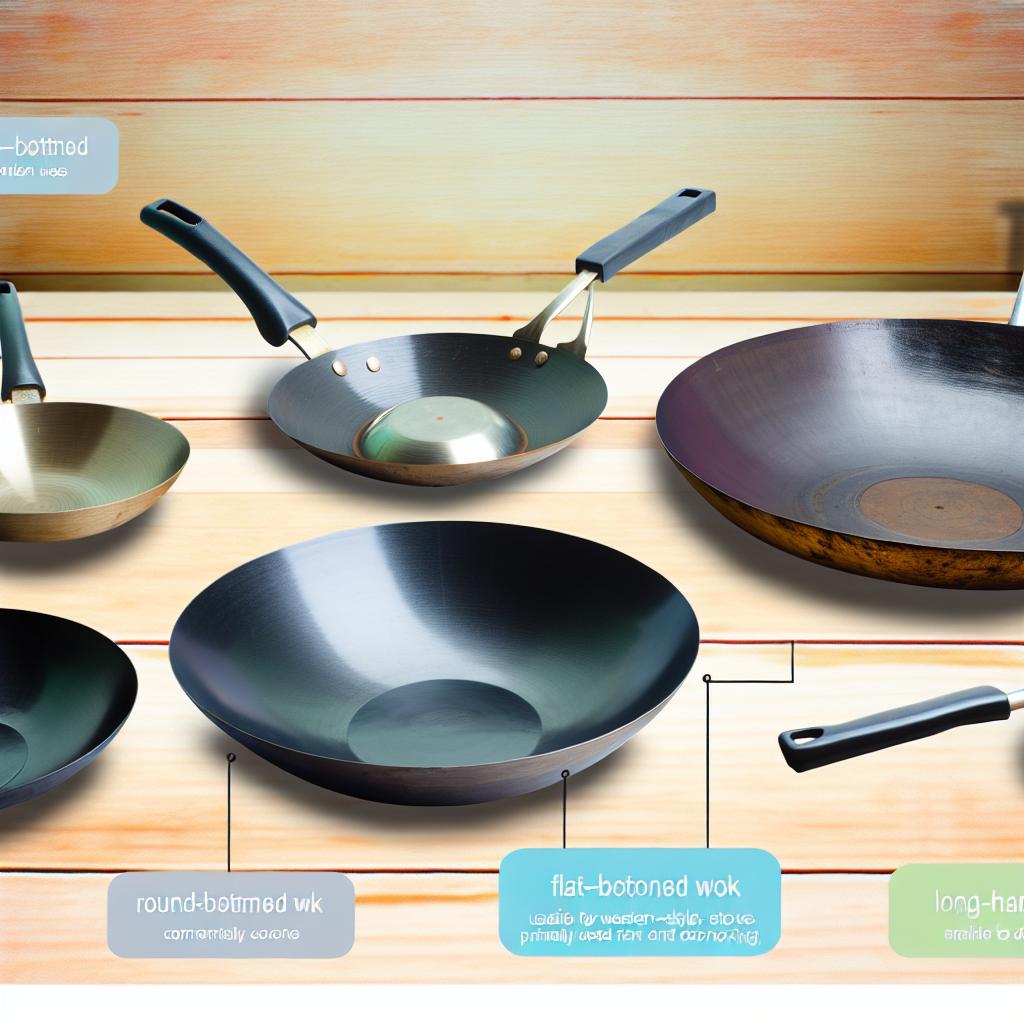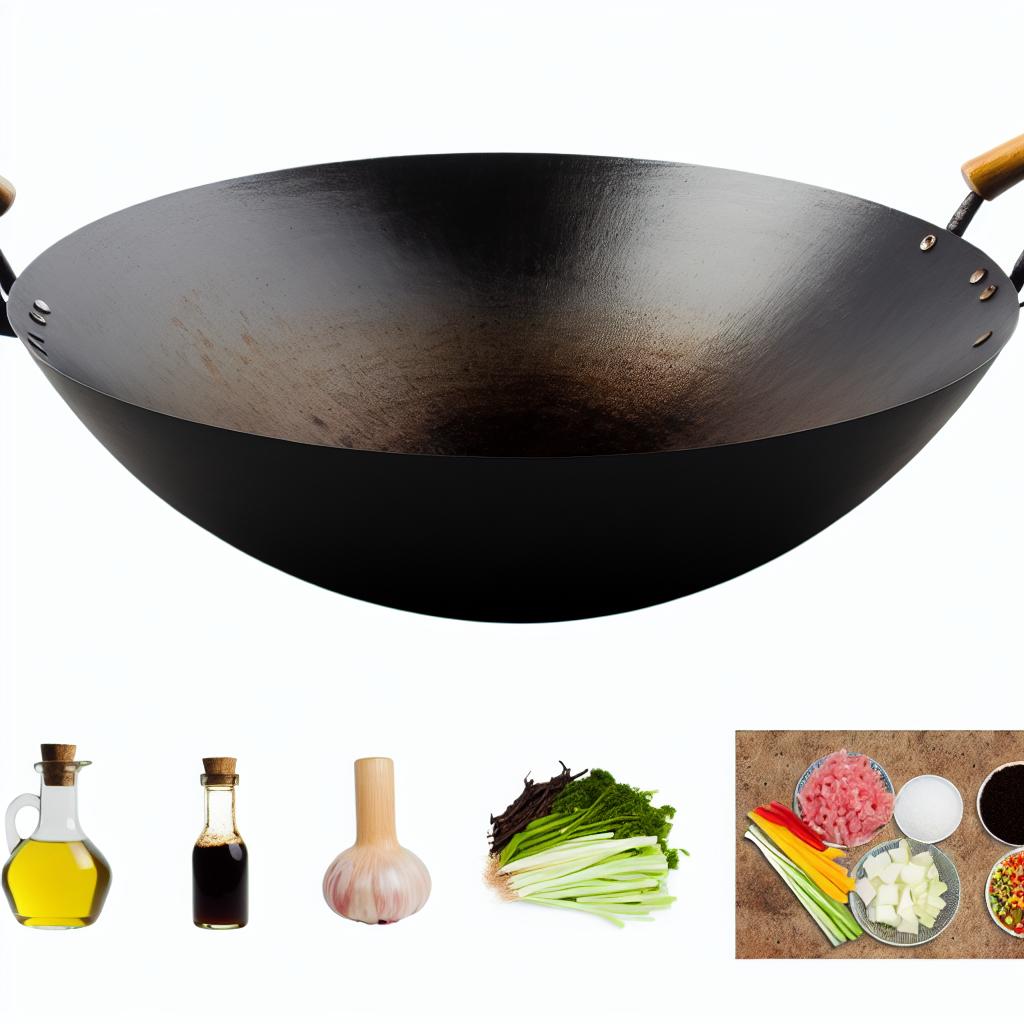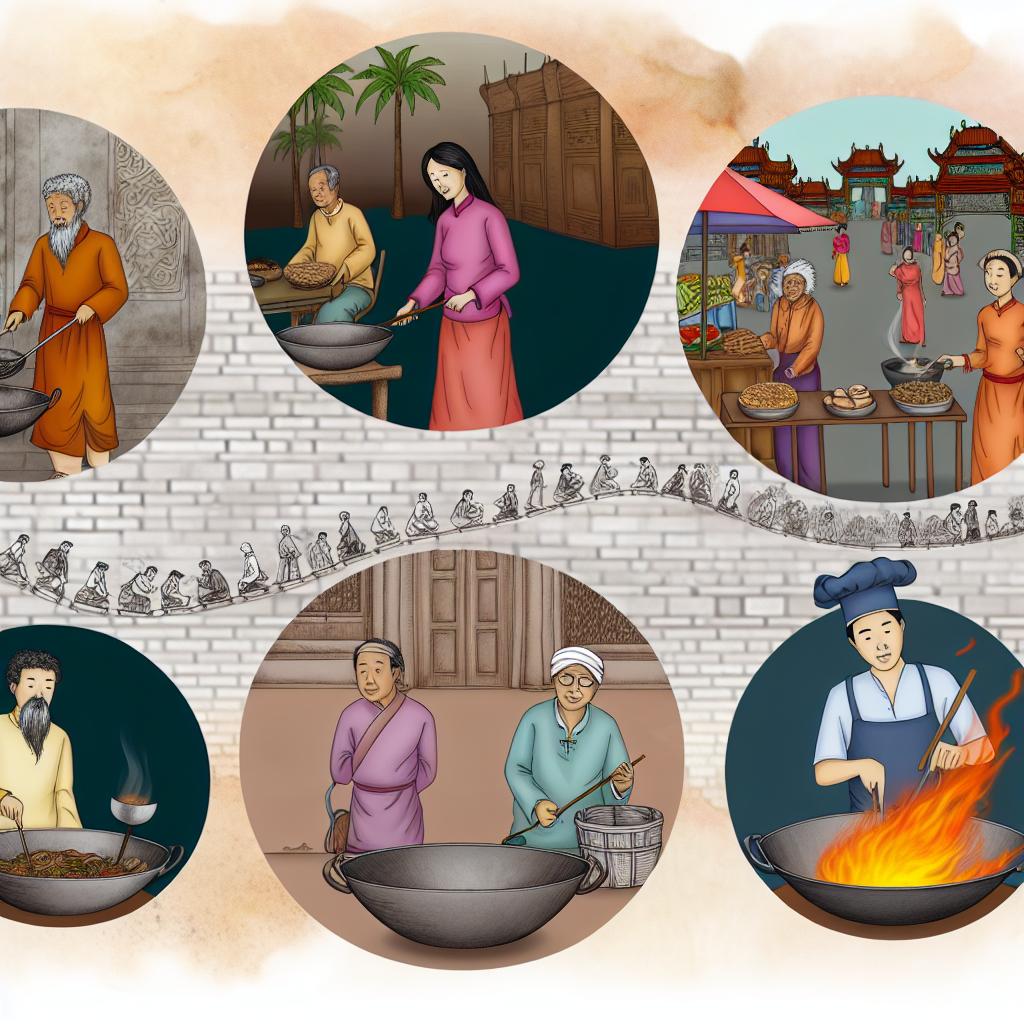Introduction to Woks
The wok is a versatile cooking pan with a deep, round bottom, primarily used in Asian cuisine. Its unique design allows for a variety of cooking methods, making it a staple in many kitchens worldwide. In this article, we will explore the different types of woks and their specific uses, helping you understand which kind might best suit your cooking style.
The Versatility of Woks
The adaptability of woks comes from their design, which allows them to be used for several cooking techniques. Their deep structure enables stir-frying, boiling, steaming, deep-frying, and smoking, turning them into a multipurpose kitchen tool. This versatility explains their enduring presence in both traditional and modern cooking arenas.
Materials and Their Impact on Cooking
When choosing a wok, the material it is made from plays a significant role in dictating its cooking performance and durability. Understanding these material differences can greatly enhance one’s cooking experience.
Carbon Steel Wok
Characteristics and Benefits: Carbon steel woks are chosen by many for their superb heat conductivity, allowing them to heat and cool quickly. This quick response to heat makes them ideal for dishes that require fast cooking. Though lightweight, they develop a natural non-stick surface over time when seasoned correctly.
Uses: Perfect for stir-frying—the swift heating aids in cooking vegetables and proteins quickly while retaining their flavors and nutrients. Moreover, the pan’s design also supports steaming, deep-frying, and smoking. Carbon steel is often preferred by chefs for its balance of responsiveness and maintainability.
Maintenance Tips for Carbon Steel Woks
To extend the life of a carbon steel wok, regular seasoning is recommended. After each use, clean the wok gently with a soft sponge to avoid removing the seasoned surface. Storing it in a dry place helps prevent rust, which can be a concern for many carbon steel products.
Cast Iron Wok
Characteristics and Benefits: Cast iron woks are recognized for their robust heat retention capabilities. Although these woks are heavier, their heat retention can be advantageous for cooking methods that benefit from consistent temperatures, leading to even cooking.
Uses: The consistent heat makes them suitable for deep-frying and slow simmering dishes like braises or stews. Additionally, their ability to maintain heat makes them excellent for high-heat searing, a method crucial for achieving the desired texture in some recipes.
Maintaining a Cast Iron Wok
Like carbon steel, cast iron requires regular seasoning to maintain its surface. Avoid soap, which can strip this coating. A light coating of oil after each use helps prevent rust and maintains the pan’s condition.
Non-Stick Wok
Characteristics and Benefits: Non-stick woks offer convenience, particularly for those wary of the maintenance required by other materials. The non-stick coating reduces the need for much oil and facilitates easier cleaning, appealing to those seeking healthier cooking options.
Uses: Suited for low to medium heat cooking, ideal for sautéing and stir-frying delicate foods like eggs or fish. However, exposure to high heat can damage the non-stick coating, limiting their suitability for some Asian cooking techniques.
Care Guidelines for a Non-Stick Wok
To ensure longevity, use non-metal utensils to prevent scratching the surface. Cooking sprays can degrade the coating, so it’s preferable to use minimal amounts of traditional oils like vegetable oil. A thorough rinse with warm water and a soft sponge suffices for cleaning.
Stainless Steel Wok
Characteristics and Benefits: Stainless steel woks are known for their exceptional durability. The material is resistant to rust and corrosion, thus requiring less maintenance compared to carbon steel or cast iron. However, stainless steel does not develop a non-stick surface, which may demand slight adjustments in cooking practices.
Uses: It excels in braising and boiling due to its ability to handle acidic foods without adverse reactions. The wok’s polished appearance makes it suitable for presenting dishes directly at the table, marrying function with aesthetics.
Cleaning and Maintenance for Stainless Steel Woks
Stainless steel can withstand a bit more abrasive cleaning compared to other materials, though it’s still wise to avoid steel wool or harsh scrubbers that can scratch the surface. Typical kitchen acids, like citrus, won’t damage stainless steel, adding to its utility.
Electric Wok
Characteristics and Benefits: These woks integrate a heat source, making them highly convenient and portable. Often featuring temperature controls, electric woks are accessible for those new to Asian cooking methods or for environments lacking a stovetop.
Uses: Their versatility extends to stir-frying, steaming, and simmering. Electric woks prove particularly useful in small or communal living arrangements where traditional single-range cooking may not be available.
Caring for an Electric Wok
Carefully follow the manufacturer’s instructions for cleaning and maintenance. Disconnect it from the power source before cleaning to ensure safety. Avoid submerging the heating elements and focus on keeping the cooking section clean and oil-free.
Choosing the Right Wok for Your Kitchen
Selecting a wok depends highly on your cooking habits, available kitchen equipment, and personal preferences. A traditionalist with an affinity for high-heat methods might favor a carbon steel or cast iron wok, while someone needing convenience might opt for a non-stick or electric model.
Conclusion
Different woks cater to diverse styles and culinary needs. Familiarity with their unique characteristics can improve your cooking experience, making meal preparation more efficient and enjoyable. Ultimately, consulting professional chefs or reliable kitchenware experts can provide further personalized guidance in choosing the most suitable wok for your kitchen.
What is a Wok?
A wok is a versatile cooking vessel originating from China, commonly used across various Asian cuisines. Its unique design makes it ideal for a range of cooking techniques, solidifying its place as an indispensable tool in many kitchens worldwide.
Design and Structure
The wok is notable for its distinctive shape, marked by a rounded bottom and high, flared sides. Traditionally crafted from carbon steel, woks are also available in materials such as cast iron, stainless steel, and non-stick coatings. This bowl-shaped design facilitates even heat distribution, which is crucial for the cooking styles typically associated with woks.
Materials Used in Wok Construction
The material from which a wok is made significantly impacts its cooking performance and maintenance requirements. Here, we’ll briefly examine the common materials used to construct woks and their respective characteristics:
Carbon Steel: Esteemed for its heat conduction properties, carbon steel woks heat up rapidly and evenly. Lightweight and affordable, they are favored by many professional and home chefs alike. However, they require proper seasoning to prevent rust and to develop a non-stick surface over time.
Cast Iron: While heavier and slower to heat up compared to carbon steel, cast iron woks retain heat exceptionally well, offering consistent cooking temperatures. These woks also need to be seasoned and are renowned for their durability.
Stainless Steel: These woks are appreciated for their durability and low maintenance. They do not rust and do not require seasoning. However, they might not offer the same heat conduction as carbon steel or cast iron, which can impact cooking.
Non-Stick Coatings: Woks with non-stick coatings are user-friendly, reducing the need for excessive cooking oil and simplifying cleanup. Care must be taken, however, to avoid scratching the non-stick surface, which can impact performance over time.
Types of Woks
There are primarily two types of woks:
– Round-bottomed woks: These are the most common and are ideal for use on gas stoves. Their shape allows for a high heat concentration at the bottom, perfect for stir-frying.
– Flat-bottomed woks: These woks are more suited to electric stovetops, as they offer a larger surface area suitable for frying.
Choosing the Right Wok for Your Cooking Needs
Selecting the appropriate type of wok depends not only on your cooking style but also on the type of stove you have. For instance, round-bottomed woks work best on traditional gas stoves. Meanwhile, flat-bottomed woks are notably efficient on electric stovetops, providing a stable base.
Uses of a Wok
The wok’s versatility is evident in its ability to perform a wide array of cooking techniques. While stir-frying is the most commonly associated method, a wok can also be utilized for steaming, boiling, deep-frying, and even smoking foods.
Stir-frying
Stir-frying involves cooking ingredients quickly at high temperature while constantly stirring. The wok’s shape facilitates the swift movement of food and its high sides help prevent spillage. This method effectively preserves the texture and flavor of vegetables and meats, making it fundamental in many Asian recipes.
Essential Tips for Stir-frying
To achieve the best results while stir-frying, it is crucial to heat the wok before adding oil. This prevents sticking and ensures even cooking. Cutting ingredients into uniform pieces allows for even cooking, and it’s essential to keep them moving within the wok to maintain the high temperature and prevent burning.
Steaming
By placing a rack inside the wok and adding a small amount of water, the wok can be transformed into a steamer. This technique is often employed for cooking dumplings, fish, and vegetables, allowing for a healthy and gentle cooking method that preserves nutrients and flavors.
Setup for Steaming
To steam using a wok, position a steaming rack inside the wok and fill the base with just enough water so that it does not touch the food placed on the rack. A wok lid or a simple kitchen towel will help trap steam. Regular attention is needed to ensure water does not dry out.
Advantages of Using a Wok
One of the primary benefits of employing a wok is its capacity to cook food quickly over high heat with minimal oil usage. This results in healthier meals with more vibrant flavors and textures. Furthermore, the wok’s shape facilitates efficient energy use by concentrating heat on the cooking surface.
Energy Efficiency and Cooking Benefits
Due to its round shape, the wok produces efficient energy use in kitchens. The focal point of the heat at the bottom allows for quick cooking, reducing energy consumption.
Caring for Your Wok
Proper care and maintenance are critical to extending the life of a wok, especially for those made of carbon steel or cast iron. Seasoning your wok helps to create a natural non-stick surface that gets better with continuous use. It’s advisable to clean regularly with hot water and a soft sponge; avoiding soap use is crucial, as it can remove the seasoned coating.
Steps for Seasoning a Wok
Seasoning a wok involves cleaning it and then applying a thin coat of oil over the surface. Heating the wok on a stove until it starts to smoke slightly lets the oil polymerize, creating a protective, non-stick layer. This process enhances with regular cooking.
Common Mistakes to Avoid
While maintaining the wok, common errors include using harsh detergents which can remove the seasoning layer or allowing moisture to stay in contact, promoting rust. Drying the wok immediately after washing is crucial in preventing rust formation.
For more information about wok usage and recipes, consider exploring resources like cookbooks or dedicated culinary websites focusing on Asian cuisines.
The Origin of Wok Cooking
The history of wok cooking is deeply intertwined with the culinary traditions of East Asia. The wok, a versatile round-bottomed cooking vessel, is believed to have originated in China over 2,000 years ago. Initially, its primary function was to roast grains, but it eventually evolved into an essential tool for various cooking techniques.
From Ancient Times to the Present
The earliest archaeological evidence of woks comes from the Han dynasty (206 BCE – 220 CE) in China. These ancient woks were made of iron and served the nascent Chinese civilization, helping shape its culinary culture. Over the centuries, the design and material of woks have evolved, but their fundamental purpose has remained constant.
Materials and Design Evolution
Traditionally, woks were crafted from heavy cast iron. The material’s excellent heat retention properties allowed for even cooking, a critical factor in stir-frying. Stir-frying itself became popular during the Ming Dynasty (1368-1644), as it offered a quick, efficient method of cooking with minimal fat.
In recent times, woks are also made from materials such as carbon steel and stainless steel. Carbon steel woks, in particular, have gained popularity due to their lightweight nature and rapid heat conduction. Stainless steel, on the other hand, offers durability and resistance to rust, making it a favorable option for modern kitchens. This evolution in materials has mirrored advances in technology and changing cooking needs.
The Spread of Wok Cooking
Wok cooking spread beyond China and became an intrinsic part of many East Asian cuisines. In countries like Thailand, Vietnam, and Malaysia, woks are used for a variety of dishes unique to their national cuisines. The flexibility of the wok allows chefs to steam, deep-fry, smoke, and more, adapting it to their culinary needs. For instance, in Thai cooking, woks are used to create flavorful dishes like Pad Thai and various stir-fried noodles.
Regional Adaptations
As wok cooking spread, it was adapted to suit local tastes and ingredients. Each culture embraced the wok, infusing their culinary traditions with this versatile cooking device. In Indonesian cuisine, the wok is used to prepare some types of sambal, a spicy condiment featured in an array of local dishes. In Korea, woks have been adapted for dishes like Japchae, a savory-sweet vegetable and noodle stir-fry, showcasing the tool’s adaptability to different flavors and textures.
Modern-Day Global Influence
Today, the wok is prevalent in kitchens worldwide due to globalization and the growing appreciation for Asian cuisine. Its versatility has made it an indispensable tool for chefs and home cooks alike. Many cooking schools and culinary institutions around the world teach the art of wok cooking, emphasizing its practical advantages and historical significance. As the popularity of Asian cuisine grows, so does interest in the cooking techniques and tools that bring these flavors into homes.
Contemporary Culinary Practices
Beyond professional kitchens, home cooks have also embraced the wok. In modern kitchens, the wok is used for an array of culinary practices, from frying eggs to creating elaborate stir-fries. Its design allows for high-heat cooking, which can sear meat quickly and maintain the crispness of vegetables. This makes it an appealing choice for health-conscious individuals seeking to prepare quick, nutritious meals without sacrificing taste.
Advancements in Wok Cooking Techniques
The evolution of wok cooking is not limited to material advancements. Techniques associated with wok cooking have also developed, adapting to modern culinary practices and equipment. The technique known as “wok hei,” which translates to “breath of the wok,” is a prized aspect of wok cooking involving intense heat to impart a unique flavor. Mastery of this technique is sought after, as it requires skill and precision to ensure food is cooked evenly while retaining a unique aroma.
Enhancing Cooking Efficiency
Beyond flavor, wok cooking is also appreciated for its efficiency. With its distinctive rounded bottom, the wok requires less oil compared to conventional pans, aligning with contemporary preferences for healthier cooking methods. The wok’s capacity to distribute heat quickly and evenly results in reduced cooking times, saving both time and energy—a benefit that resonates well with the busy lifestyles of today’s home cooks.
Global Culinary Impact
Globally, the influence of wok cooking can be seen in various fusion cuisines that incorporate Asian ingredients and techniques. Chefs worldwide draw inspiration from traditional Asian methods, integrating them into innovative dishes that feature local produce and flavors.
Future Directions
The future of wok cooking is poised to keep pace with the evolving dynamics of the culinary world. As interest in sustainable cooking rises, the wok’s adaptability may play a role in reducing energy consumption and food waste. As more chefs and home cooks look to minimize their ecological impact, the wok’s efficient cooking methods and ability to create diverse meals from available ingredients may support these sustainable goals.
For further exploration of wok cooking techniques and recipes, you might consider referring to specialized culinary resources or cooking schools that offer courses on Asian cuisine. Embracing the art of wok cooking opens up a world of possibilities, celebrating a rich heritage while embracing the flavors and innovations of the modern culinary landscape.


